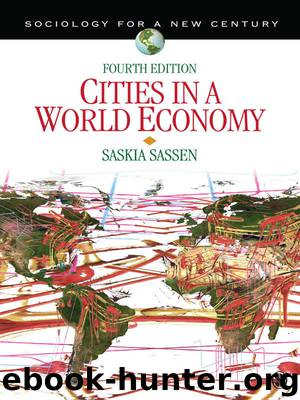Cities in a World Economy: Volume 4 (Sociology for a New Century Series) by Saskia Sassen

Author:Saskia Sassen [Sassen, Saskia]
Language: eng
Format: azw3
ISBN: 9781483342283
Publisher: SAGE Publications
Published: 2011-08-31T04:00:00+00:00
The Space Economy of Centrality
What are the spatial consequences of this new economic core of activities? What is the urban form that accommodates them?
Three distinct patterns are emerging in major cities and their regions in the developed countries and increasingly also in the rest of the world. First, beginning in the 1980s, there was an increase in the number of firms in the centers of major cities mostly explained by growth in leading sectors and ancillary industries. This type of economic growth in city centers also took place in some of the most dynamic cities in rapidly growing Global South countries, such as Seoul, Bangkok, Taipei, Mumbai, São Paulo, Mexico City, and Buenos Aires. Second, along with this central city growth came the formation of dense nodes of commercial development and business activity in a broader urban region, a pattern that is less evident in developing countries except in the export-oriented growth poles discussed earlier or in cities such as Johannesburg, which are undergoing major social transformation in their centers. These nodes assumed different forms: suburban office complexes, edge cities, exopoles, and urban agglomerations in peripheral areas. Edge cities are significant concentrations of offices and business activities alongside residential areas in peripheral areas that are completely connected to central locations via state-of-the-art electronic means. Until recently, these urban forms were only rarely evident in developing countries, where vast urban sprawl with a seemingly endless metropolitanization of the region around cities has been the norm. But by 2010, it had become clear that they are now present across the world (Ciccolella and Mignaqui 2002; Ren 2011). In developed countries, the revitalized urban center and the new regional nodes together constitute the spatial base for cities at the top of transnational hierarchies. The third pattern is the growing intensity in the localness, or marginality, of areas and sectors that operate outside that world market-oriented subsystem, and this includes an increase in poverty and disadvantage. A significant exception to this trend toward a peripheral localness is the emergence of what I call global slums—major slums in global cities that are positioning themselves as actors on a global stage (Sassen 2011b). The general dynamic that emerges from these three patterns operates in cities with very diverse economic, political, social, and cultural arrangements. There is by now a vast scholarship on these trends and spatial arrangements that took off in the 1980s and continued through the early 2000s (see, among others, Cobos 1984; Gans 1984; Hausserman and Siebel 1987; Henderson and Castells 1987; Cheshire and Hay 1989; Benko and Dunford 1991; Scott 2001; Krause and Petro 2003; Abrahamson 2004; Gugler 2004; Rutherford 2004; Amen, Archer, and Bosman 2006; Sassen 2008b).
A few questions spring to mind. One question is whether the type of spatial organization characterized by dense strategic nodes spread over the broader region might constitute a new form of organizing the territory of the center. This would contrast with the more conventional view that sees it as an instance of suburbanization or geographic dispersal.
Download
This site does not store any files on its server. We only index and link to content provided by other sites. Please contact the content providers to delete copyright contents if any and email us, we'll remove relevant links or contents immediately.
| Anthropology | Archaeology |
| Philosophy | Politics & Government |
| Social Sciences | Sociology |
| Women's Studies |
Nudge - Improving Decisions about Health, Wealth, and Happiness by Thaler Sunstein(7261)
iGen by Jean M. Twenge(5167)
The Fire Next Time by James Baldwin(5025)
Adulting by Kelly Williams Brown(4242)
The Hacking of the American Mind by Robert H. Lustig(4094)
The Sports Rules Book by Human Kinetics(4081)
The Ethical Slut by Janet W. Hardy(4042)
Captivate by Vanessa Van Edwards(3733)
Mummy Knew by Lisa James(3523)
In a Sunburned Country by Bill Bryson(3376)
The Worm at the Core by Sheldon Solomon(3328)
Ants Among Elephants by Sujatha Gidla(3282)
Suicide: A Study in Sociology by Emile Durkheim(2908)
The Slow Fix: Solve Problems, Work Smarter, and Live Better In a World Addicted to Speed by Carl Honore(2844)
The 48 laws of power by Robert Greene & Joost Elffers(2818)
Humans of New York by Brandon Stanton(2694)
Handbook of Forensic Sociology and Psychology by Stephen J. Morewitz & Mark L. Goldstein(2606)
The Happy Hooker by Xaviera Hollander(2586)
The Tipping Point by Malcolm Gladwell(2565)
